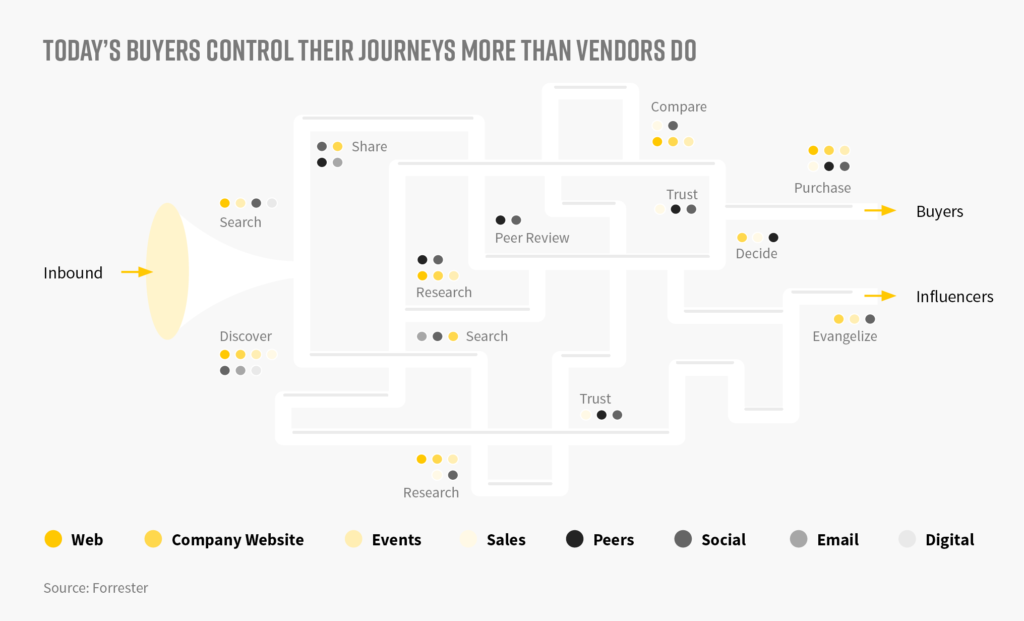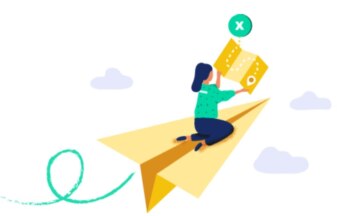This post is the latest in our series on B2B marketing optimization and how to take your marketing efforts to the next level.
Earlier on the ON24 blog, we looked at what is optimization for B2B marketers and why it is important.
In this post, we make the case that when it comes to optimization, focusing on just the early stages of the customer journey is unlikely to be the most effective.
Optimization needs to be aligned with how customers take their journeys
The previous article touched briefly on how the customer journey for B2B purchases differs to those within B2C.
While those selling to consumers often only have to deal with a single individual and can manage almost their whole experience through the website, B2B marketers have to contend with multiple people in a buying unit, lengthier and more complex sales cycles, and the fact that the ultimate point of revenue is looked after by departments other than marketing – those being sales and customer success (i.e. post-purchase and renewals) teams.
Buyers and buying teams also do not take linear paths. Instead, they choose their own journeys by interacting with a mixture of self-service content and conversations with people, as illustrated in the image below from ON24’s e-book on The Engagement Imperative.

Customers and prospects don’t care about singular points and events
In marketing, the measurement of performance often comes down to a single event or trigger. For example, when a lead form is completed or a prospect passes a lead score threshold that makes them qualified for sales.
It might be tempting for marketers to simply look at optimization in terms of only their targets – for example, the number of MQLs generated or the total value of marketing-sourced pipeline. However, buyers don’t see their process as being defined by your company’s own processes or departmental siloes.
These targets might help align processes and actions internally, but the customer doesn’t care about crossing such arbitrary thresholds.
As such, B2B marketers looking to make a real impact need to approach optimization from the customer’s perspective. This means looking at each part of their journey and finding out how to improve it, regardless of whether that step is typically owned by marketing.
The mindset around optimization needs to be wide. And if marketing is supposed to ‘own’ the customer experience, their responsibility cannot simply end when there is a handover to sales.
The whole customer journey has value
Because the whole experience of interactions between a prospect or customer influences their decision to ultimately make or influence a purchase decision, optimization needs to look at the journey in its entirety to have the most significant impact.
Furthermore, because retention is almost always far cheaper than acquisition, and because existing customers make the best advocates, any approach to optimization should look across the entirety of the customer journey.
A three-stage approach to the customer journey
So how can B2B marketers tackle this complexity without inducing too much confusion? Your organization may already have customer journey maps that break down each stage. In this case, that framework may provide a good start when it comes to optimization.
If you don’t have buyer journeys already mapped out, we recommend dividing the journey up into three stages for the purposes of optimization:
Stage 1: Acquisition
This part of the customer journey is the one traditionally associated with marketing. Questions to ask as part of your optimization efforts include:
- What can we optimize to increase our reach across our total addressable market?
- What can we optimize to increase coverage within target accounts?
- How can we optimize our on-page conversion rates for landing pages and lead forms?
- How can we optimize the research stage of the customer journey to encourage more content downloads and consumption?
- How can we optimize engagement during webinars and other events to qualify prospects for sales?
Stage 2: Engagement and Conversion
This stage of the customer journey is typically owned by both marketing and sales, with the latter taking more control as the sales process progresses. Questions to ask here for your customer engagement marketing include:
- How can we optimize the handover from automated marketing to direct sales content?
- How can we optimize the self-serve experience even as prospects are speaking with colleagues in sales?
- How can we optimize the interaction between salespeople and prospects?
- How can we optimize the sales experience through content and collateral?
Stage 3: Retention and Loyalty
This stage of the customer journey comes after purchase. In many companies, the salesperson responsible for closing the deal then hands off to customer success or an account manager. Optimization questions to ask here include:
- How can we optimize the onboarding experience?
- How can we optimize how customers educate themselves and find out more about the product or service?
- How can we optimize engagement for existing customers?
- How can we optimize customer advocacy?
The posts over the coming weeks will explore these three areas in detail – and how webinars can be an instrumental part in optimizing the entirety of the customer journey.
If you can’t wait for our next posts, the 3rd session of the W.E.B.I.N.E.R.D. Education Curriculum is all about optimization. Sign up to get started and watch all previous sessions on demand!
